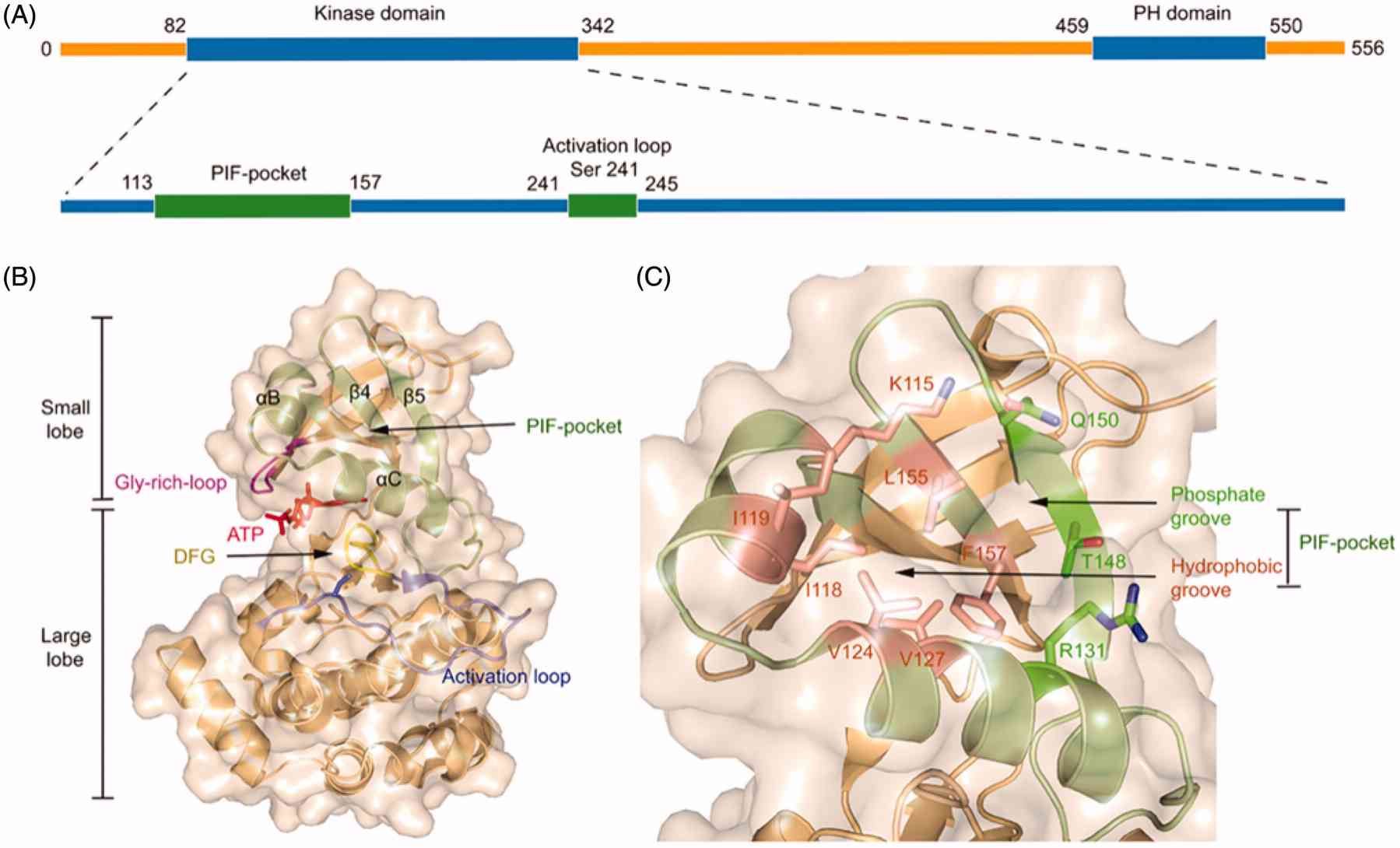What is PDK1 Protein
The Phosphoinositide-Dependent Kinase-1 (PDK1) protein occupies a pivotal position in cellular signaling, influencing various physiological processes.
What is PDK1 Protein?
PDK1, encoded by the PDPK1 gene, stands as a key regulator in the Protein Kinase B (PKB) pathway. A serine/threonine kinase, PDK1 exhibits a sophisticated structure characterized by distinct domains. The N-terminal pleckstrin homology (PH) domain facilitates membrane localization, while the central catalytic kinase domain phosphorylates target proteins. The C-terminal hydrophobic motif-binding domain enhances substrate specificity, collectively forming a dynamic molecular architecture.

Figure 1. The structure of PDK1. (Xu, X., et al. 2019)
The Function of PDK1 Protein
At its core, PDK1 orchestrates the activation of AGC kinases, notably PKB/Akt, through precise phosphorylation events. Upon extracellular stimulation, PDK1 translocates to the cell membrane, where it engages with phosphoinositides, facilitating the recruitment and activation of PKB/Akt. This activation cascade is pivotal in governing cell survival, growth, and metabolism.
PDK1-Related Diseases
- Cancer
Elevated PDK1 activity emerges as a hallmark in various cancer types, fostering uncontrolled cell proliferation. Targeting PDK1 has shown promise in impeding cancer progression, making it a potential therapeutic avenue.
- Diabetes
PDK1's intricate involvement in insulin signaling renders it a key player in diabetes pathology. Dysregulation of PDK1 function contributes to insulin resistance, emphasizing its relevance in understanding and managing type 2 diabetes.
- Neurological Disorders
Implications of altered PDK1 activity extend to neurological disorders such as Alzheimer's and Parkinson's disease. Unraveling the role of PDK1 in neuronal survival unveils potential therapeutic targets for neurodegenerative conditions.
PDK1 Related Signaling Pathways
PDK1's influence extends beyond the PKB/Akt pathway, integrating into crucial signaling cascades.
- mTOR Pathway
PDK1 plays a central role in the mTOR pathway, regulating protein synthesis, cell growth, and autophagy. Understanding its impact on mTOR signaling provides insights into broader cellular processes.
- MAPK Signaling
Implications of PDK1 in MAPK signaling underscore its influence on cellular responses to growth factors and stress signals. The intricate interplay between PDK1 and MAPK signaling contributes to cellular homeostasis.
Applications of PDK1 in Biomedical Research
- Drug Development
Targeting PDK1 in drug development emerges as a promising strategy, particularly in cancer therapeutics. Small molecule inhibitors designed to modulate PDK1 activity show efficacy in preclinical studies, paving the way for novel anticancer interventions.
- Biomarker Discovery
Monitoring PDK1 activity as a biomarker holds diagnostic potential across various diseases. Evaluation of PDK1 status in patient samples may offer valuable insights for early diagnosis, prognosis, and treatment stratification.
- Therapeutic Target
Precision modulation of PDK1 activity presents a therapeutic frontier in diseases characterized by aberrant cell signaling. Developing targeted therapies aimed at PDK1 offers a nuanced approach with potential clinical benefits.
PDK1 protein emerges as a central player in cellular signaling, weaving its influence through diverse pathways and processes. From its intricate structure to its pivotal role in diseases and promising applications in biomedicine, PDK1 stands as a focal point for scientific exploration and therapeutic innovation.
Recommended Products for PDK1 Protein
| Cat.# | Species | Product name | Source (Host) | Tag |
|---|---|---|---|---|
| PDK1-123H | Human | Recombinant Human Pyruvate dehydrogenase kinase, isozyme 1, His-tagged | E.coli | His |
| PDK1-904H | Human | Recombinant Human PDK1, His tagged | Insect Cell | His |
| PDK1-6460H | Human | Recombinant Human PDK1 Protein, Myc/DDK-tagged, C13 and N15-labeled | HEK293T | Myc/DDK |
| PDK1-7254HF | Human | Active Recombinant Full Length Human PDK1 Protein, GST-tagged | Insect (sf21) | GST |
| PDK1-1638H | Human | Recombinant Human PDK1 Protein, His (Fc)-Avi-tagged | HEK293 | His (Fc)-Avi |
| PDK1-12583M | Mouse | Recombinant Mouse PDK1 Protein | Mammalian Cell | His |
| Pdk1-8026M | Mouse | Recombinant Mouse Pdk1 protein, His & T7-tagged | E.coli | His/T7 |
| Pdk1-4766M | Mouse | Recombinant Mouse Pdk1 Protein, Myc/DDK-tagged | HEK293T | Myc/DDK |
| Pdk1-1932R | Rat | Recombinant Rat Pdk1 Protein, His-tagged | E.coli | N-His |
| PDK1-3005C | Chicken | Recombinant Chicken PDK1 | Mammalian Cell | His |
Reference
- Xu, X., et al. The chemical diversity and structure-based discovery of allosteric modulators for the PIF-pocket of protein kinase PDK1. J Enzyme Inhib Med Chem. 2019, 34(1): 361-374.

